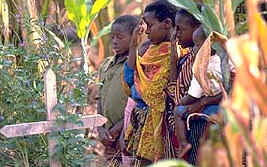Expanded Prevention Programs Could Prevent 29 Million New HIV Infections by 2010
(Geneva, July 3, 2002) An expanded global response to the AIDS epidemic based on 12 essential interventions to reduce HIV transmission could prevent some 29 million new HIV infections among adults by 2010, according to an article published in The Lancet medical review on July 6.
The article, written by a group of international experts convened by the Joint United Nations Program on HIV/AIDS (UNAIDS) and the World Health Organization (WHO), however warns that delay in implementation of the prevention package will dramatically reduce the number of infections that can be prevented. Implementation of the full package by 2005 could cut new infections by 64%, lowering the number of adults infected each year from over four million currently to approximately 1.5 million. Analyses suggest that just a three-year delay could reduce these potential gains by 50%.
"Implementing these interventions immediately could avert many new infections and dramatically alter the course of the epidemic," said Neff Walker UNAIDS Senior Advisor on Statistics, Modeling and Projections, one of the authors of the article. "If the interventions do not take place, we could see as many as 45 million new infections by the end of the decade."
Over the first four years, the total cost of bringing prevention programs to scale is estimated to be US$8.4 billion. From 2005 onwards, the expanded prevention program will cost an estimated US$4.8 billion annually. The full costs of scaling-up and sustaining the effort to 2010 are estimated to be US$ 27 billion, or a total of some US$1000 per infection averted.
"The implementation of this package presents many challenges," said Bernhard Schwartlander, Director of WHO's Department of HIV/AIDS, another of the report's authors. "However, analyses show that these coverage levels are achievable and that the goals of reducing prevalence levels by 25% by 2010, adopted by all governments at the UN Special Session on HIV/AIDS last year, can be met."
The 12 prevention interventions include mass media campaigns; public sector condom promotion and distribution; condom social marketing; voluntary counseling and testing programs; prevention of mother-to-child transmission; school-based programs; programs for out-of-school youth; workplace programs; treatment of sexually transmitted infections; peer counseling for sex workers; outreach to men who have sex with men; and harm reduction programs for injecting drug users.
 The article cautions that the effects of the
prevention activities will only yield the expected results
in the presence of strong care and support programs. In
previous work the authors also identified nine different
care and support activities which would require an
additional US$ 4.4 billion annually by 2005 for full
implementation in low- and middle-income countries.
The article cautions that the effects of the
prevention activities will only yield the expected results
in the presence of strong care and support programs. In
previous work the authors also identified nine different
care and support activities which would require an
additional US$ 4.4 billion annually by 2005 for full
implementation in low- and middle-income countries.
The article says that the proportion of infections averted in different countries will vary, from a low of 40% in countries with stable or declining prevalence, such as Senegal or Thailand, to a high of 70% in countries with rapidly growing epidemics, such as Cameroon or China. Nearly a third of the benefits from the intervention package will accrue to two countries, India and China, with another 40% in sub-Saharan Africa.
copyright
